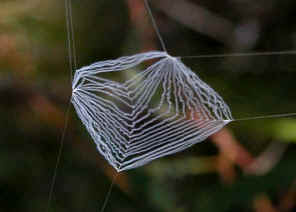|
| |
FAMILY Deinopidae (Dinopidae)- Net-casting
Spiders
- The species in this family are large and slow moving spiders. They have long
body and stick like legs. Their bodies are light brown or grey in colour. They
do not build permanent web, instead, they hold the net and throw it towards
their prey.
 -
- Some species of this family have a pair of eyes that are unusually large.
They have another common name Ogre-face
Spiders. Their big eyes help them to see in the dark.
-
 - Net of Net-casting Spider, the cribellate silk
-
- They usually hide in low shrubs and bushes during the day.
-


 -
- Egg-sac and spiderlings.
-


 -
-
- Common Net-casting Spider
  - Deinopis ravidus, male leg to leg 80mm,
female leg to leg 60mm
- Common Net-casting Spiders are large and slow moving
spiders. They have long body, up to 30mm, and stick like legs. Their bodies are
light brown or grey in colour. They do not build permanent web, instead, they
hold the net and throw it towards their prey. We have details information in
this page.
-
-
- Net-casting Spider
  - Deinopis subrufa (Dinopis bicornis), male leg to leg 80mm,
female leg to leg 60mm
- This Net-casting Spiders look similar to the above species. The only different
are the pattern on the male and female's abdomen. They are found sometimes on
the lower plants in backyards. Please also check this page
for more information.
-
-
- Small-eyes Net-caster

 - Avella angulata (former Menneus angulata), leg to leg 60mm
- Pictures taken in Karawatha Forest during mid summer. This Net-casting Spider
does not have the pair of large eyes, like the other species in this family
does. Please also check this page.
-
- Reference:
- 1. A Guide to Australian Spiders - Densey Clyne, Melbourne, Nelson
1969, p64.
- 2. Deinopidae
- The Find-a-spider Guide for the Spiders of
Southern Queensland, Dr Ron Atkinson, 2009.
- Back to top
- [ Up ] [ Spider Scientific Facts ] [ How spider builds its web ? ] [ Nephilid Spiders ] [ Long-jawed Orb Weavers ] [ Lace Wed Spiders ] [ Daddy Long-leg Spiders ] [ Comb-Footed Spiders ] [ Net-casting Spiders ] [ Uloborid spiders ] [ Unknown Spiders ]
| |
|














